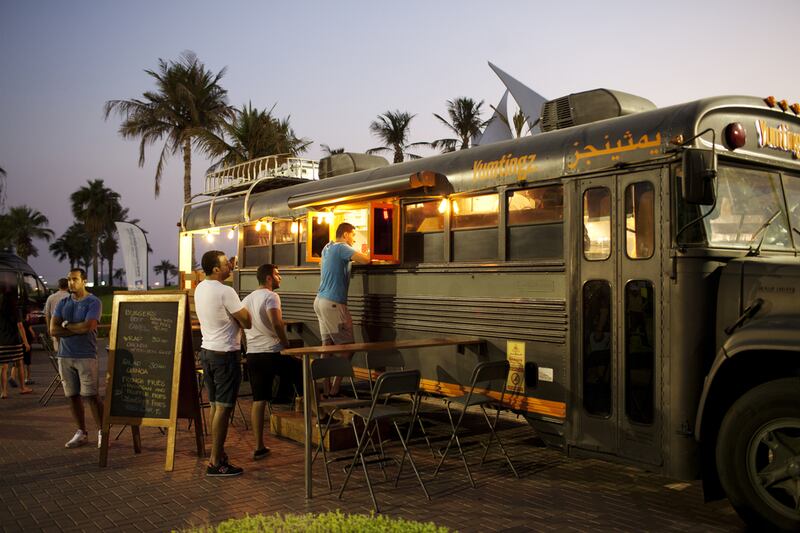You often have to stand in queues and eat off paper plates – yet a growing number of diners have been won over by the variety and charm of authentic, creative, food-truck grub.
Dedicated “truck parks” are opening – the most recent being The Last Exit Al Qudra, at the end of Dubai’s D63 road – and the food vans have also become a common sight at events across the country.
About 35 participate, for example, in culinary events organised by Alexandre Teodoresco, the man behind Truckers DXB and Street Food Market DXB.
“Some people have had enough of Dubai’s VIP five-star super-expensive treatment,” says Teodoresco. “They want home-grown rather than big international franchises.”
When he organised his first event, Street Nights, four years ago, he could only find one food truck in the country. Now there are about 60, and in Abu Dhabi it has become easier to operate them out with organised events, with Mawaqif issuing permits.
But standing out in an increasingly crowded market takes a lot more than just offering tasty bites. “I see trucks getting more imaginatively decorated,” says Teodoresco. “They have no choice. It can’t be just another restaurant on wheels.”
While still in its infancy here, the industry is more established in the United States and Europe, where it appeals to war veterans, entrepreneurs and chefs tired of working for others, says Reema Shetty, whose Dubai company, The Foodsters Inc, has built a stable of 30 trucks.
She believes creating a food-truck concept requires passion, perseverance and the ability to innovate. “We have real chefs working behind the counters. We believe that you should engage with culinary experts if you want to always push the barriers of innovation.”
Khalid Al Mansoor, chairman of truck provider “Truck It”, sees the concept expanding beyond food. “It could be a salon, a hairdresser, nails service – any commercial activity,” he says. “Why not do mobile manicures from a truck?”
The concept
There are two approaches, says Michael Stojkovic, marketing director for Food Truck Co, a million-dollar fund in Dubai that owns five food trucks and has eight in production. “Some people follow their dreams, such as Zapie Kanka, which serves open, Polish-style sandwiches, because one of the partners is Polish and they really believe in their food,” he says.
“For others, it’s about what customers will be comfortable with. Anything with a burger is a fast sell in this region.”
One of Food Truck Co’s most successful concepts is Sir Loin & Sons, a truck with a six-metre meat smoker tailor-made in Texas.

Jamal Wick of Flip Management. Victor Besa for The National
“We spent three months sitting together [in our Business Bay offices] with our creative team throwing around ideas about what are the best concepts that fit food trucks today,” says company co-founder, Jamal Wick. “You can’t have a menu with 25 items, because the space within food trucks is very limited. In terms of pricing, no one’s going to pay Dh250 to eat out of a truck.”
Developing the menu
All trucks need a standout item, Teodoresco adds. “Something really special that will have social-media followers looking for you.”
Coming up with that signature dish can take two to three months of food tastings, adds Wick.
As the food-truck scene expands, entrepreneurs are on the lookout for untapped food truck-friendly cuisine concepts. The Food Truck Co will launch an Asian duck-pancake truck and a Greek souvlaki (grilled meat skewers) concept next month. While Truck It has created a cornflakes-themed truck, Flakes Hub, and just launched Japanese bakery concept, Keki. “The market is always hungry for something new,” says Al Mansoor.
Sourcing the truck
Many of the trucks in the UAE are vintage vehicles with colourful pasts. The team behind Yumtingz, for example, spent two and a half months converting an old school bus into a mobile outlet that serves up camel burgers and roasted-roots salad.
“We’ve produced about 18 vintage trailers, with another 20 in the pipeline,” says Shetty. “We’ve gone a little crazy and restored everything from a 1965 airstream to containers and horse trailers and trucks.”

Reema Shetty, who co-founded Foodsters company. Victor Besa for The National
Bitar took a road trip touring scrapyards in the United States, to find partners to supply old bodies for their vintage trailers. They are shipped to the UAE, then restored and fitted out in Dubai– “because the specs [voltage and regulations] in the US are different and the insulation you get there isn’t sustainable for the UAE environment,” says Bitar.
A mobile kitchen like Foodsters Inc’s Lola can cost from Dh150,000 to Dh500,000, he says.
“We started with a garage that can produce four trailers a month, and are now moving into a 15,000sq ft facility with a capacity to produce more than 15 trucks and trailers a month,” he adds.
Truck It’s vehicles also originate in the US, but arrive as fully operational MT45 freight liner trucks which were Fed Ex and UPS delivery vehicles previously. “These trucks are legends – they’ve been used and tested in the US for many years,” says Al Mansoor.
The Foodsters Inc also custom-build trailers and trucks, which Shetty says can be more cost-effective.
The design
The final, and one of the most important stages of the food truck creation process, is the branding. Graphic designers are enlisted to create a design, and a local foil-wrap company to transfer it to the vehicles. Many of today’s trucks are heavily decorated with graphics, spray-painted artwork and stickers.
“It’s the added extras that make the truck really stand out,” says Stojkovic.
artslife@thenational.ae






